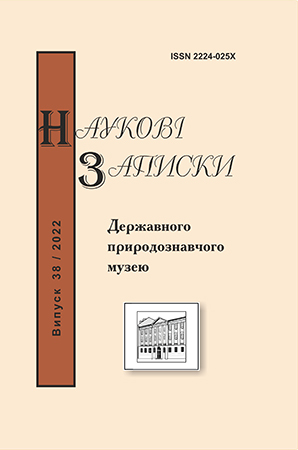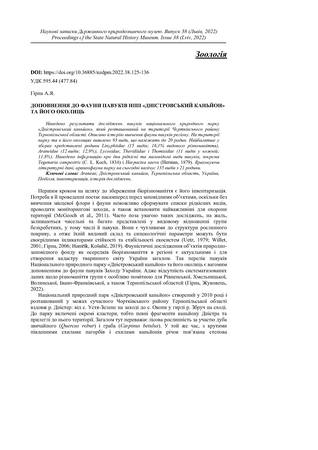Hirna A.Ya.
A contribution to the spider fauna of the Dnister Canyon NNP and its environs // Proc. of the State Nat. Hist. Mus. - Lviv, 2022. - 38. - P. 125-136 DOI: https://doi.org/10.36885/nzdpm.2021.38.125-136 Key words: Araneae, Dnister Canyon, Ternopil Oblast, Ukraine, Podolia, inventory, research history The research on the spider fauna of the Dnister Canyon National Nature Park, which is located on the territory of the Chortkiv district of the Ternopil oblast (Ukraine), is presented. The study area lies within the deciduous forest zone in the region of Roztochia-Opillian hill ridges and the West Podolian upland region. The history of the study of the spider fauna in the region is analyzed, including the one related to the works of famous naturalists of the 19th century: A. Wierzejski, M. Łomnicki, L. Wajgiel, M. Nowicki, and L. Koch. It was established that most of the clusters of the National Nature Park were not covered by the research, and its faunal list includes only about 85 spider species, and even then, a significant part of them was collected on the outskirts of the protected area. During the several-day expeditions in 2000 and 2016, 93 species belonging to 20 families were found. The species-rich families were Linyphiidae (15 species; 16.1% of species diversity), Araneidae (12 species; 12.9%), Lycosidae, Theridiidae, and Thomisidae (11 species each; 11.8%). Information on the distribution in the world and in Ukraine of two rare and little-known species of spiders, namely Tegenaria campestris (C. L. Koch, 1834) and Harpactea saeva (Herman, 1879), which were found in a rotten log in an oak-hornbeam forest, is given. Taking into account the literature-derided data, the fauna of the park currently includes 135 spider species from 21 families. During the research, 42 species of spiders were not confirmed. First of all, this is due to the very short period of expeditions and the lack of stationary study plots, and therefore of materials from pitfall traps or seasonal from spring to autumn collections. In particular, no tarantula (Lycosa singoriensis) was found. This species was typical and widespread in Podolia at the end of the 19th century, however, according to a survey of local residents, it is now very rare, and its records on the territory of the National nature park need confirmation. To supplement the fauna and understand the features of its formation in the region, further comprehensive research of zonal forests and steppe areas on the slopes of river canyons is necessary.
A contribution to the spider fauna of the Dnister Canyon NNP and its environs // Proc. of the State Nat. Hist. Mus. - Lviv, 2022. - 38. - P. 125-136 DOI: https://doi.org/10.36885/nzdpm.2021.38.125-136 Key words: Araneae, Dnister Canyon, Ternopil Oblast, Ukraine, Podolia, inventory, research history The research on the spider fauna of the Dnister Canyon National Nature Park, which is located on the territory of the Chortkiv district of the Ternopil oblast (Ukraine), is presented. The study area lies within the deciduous forest zone in the region of Roztochia-Opillian hill ridges and the West Podolian upland region. The history of the study of the spider fauna in the region is analyzed, including the one related to the works of famous naturalists of the 19th century: A. Wierzejski, M. Łomnicki, L. Wajgiel, M. Nowicki, and L. Koch. It was established that most of the clusters of the National Nature Park were not covered by the research, and its faunal list includes only about 85 spider species, and even then, a significant part of them was collected on the outskirts of the protected area. During the several-day expeditions in 2000 and 2016, 93 species belonging to 20 families were found. The species-rich families were Linyphiidae (15 species; 16.1% of species diversity), Araneidae (12 species; 12.9%), Lycosidae, Theridiidae, and Thomisidae (11 species each; 11.8%). Information on the distribution in the world and in Ukraine of two rare and little-known species of spiders, namely Tegenaria campestris (C. L. Koch, 1834) and Harpactea saeva (Herman, 1879), which were found in a rotten log in an oak-hornbeam forest, is given. Taking into account the literature-derided data, the fauna of the park currently includes 135 spider species from 21 families. During the research, 42 species of spiders were not confirmed. First of all, this is due to the very short period of expeditions and the lack of stationary study plots, and therefore of materials from pitfall traps or seasonal from spring to autumn collections. In particular, no tarantula (Lycosa singoriensis) was found. This species was typical and widespread in Podolia at the end of the 19th century, however, according to a survey of local residents, it is now very rare, and its records on the territory of the National nature park need confirmation. To supplement the fauna and understand the features of its formation in the region, further comprehensive research of zonal forests and steppe areas on the slopes of river canyons is necessary.
References
- Гірна А.Я. 2006. Антропогенна динаміка угруповань павуків (Arachnida, Aranei) ясенево-дубових лісів Верхньодністровської рівнини. Автореферат дисертації кандидата наук, Дніпропетровський національний університет. Дніпропетровськ. 20 с.
- Гірна А.Я. 2014. Анотований список павуків Гологірського району Розтоцько-Опільської горбогірної області (північно-західне Поділля). Наукові основи збереження біотичної різноманітності. Том 5(12) № 1. C. 91–144.
- Гірна А.Я. 2016. Антропогенно зумовлені зміни видового складу і структури угруповань павуків у лучно-степових екосистемах Гологірського пасма (Північно-Західне Поділля). Наукові основи збереження біотичної різноманітності. Том 7(14) № 1. С. 85–102.
- Гірна А., Жукавець Є. 2022. Каталог павуків (Arachnida, Aranei) Львівської області (Україна). Львів. 312 с.
- Гурьянова В.Е. 2003. Материалы к фауне пауков Подольской лесостепи (Украины). Вестник зоологии. Том 37 № 5. С. 3–11.
- Євтушенко К. 2004. «Павуки (Aranei)», в: Фауна печер України (за ред. І. Загороднюка). Київ. С. 64–68.
- Кагало О.О., Мандзюк Л.О. 2012. «НПП Дністровський каньйон», в: Фіторізноманіття заповідників і національних природних парків України. Ч. 2. Національні природні парки (за ред. В.А. Онищенка і Т.Л. Андрієнко). Київ. С. 249–259.
- Ковблюк Н.М., Прокопенко Е.В., Надольный А.А. 2008. Пауки семейства Dysderidae Украины (Arachnida, Aranei). Евразиатский энтомол. журнал. Том 7 № 4. С. 287–306.
- Левушкин С.И. 1962. К фауне пещер Приднестровья. Бюл. Моск. о-ва испытателей природы. Том 67 Вып. 3. С. 29–37.
- Маринич О.М., Пархоменко О.Г., Петренко О.М., Шищенко П.Г. 2003. Удосконалена схема фізико-географічного районування України. Укр. географ. журн. № 1. С. 16–20.
- Федоряк М.М., Марко Ю.М. 2014. Павуки-герпетобіонти Національного природного парку «Хотинський» (ранньовесняний аспект) // Матеріали I Міжнар. наук.-практ. конф. «Регіональні аспекти флористичних і фауністичних досліджень» (10-12 квітня 2014 р., м. Хотин). Збірник матеріалів. Чернівці. C. 154–157.
- Fedoriak M., Zhukovets E. 2011. Spiders of Chernivtsi city (Ukraine): a comparison actual species composition and species recorded by A. Roşso (1930-1938) // Biodiversitatea şi Managementul Insectelor din România. Simpozion (Suceava, 24-25 septembrie 2010). Book of Abstracts. P. 157–169.
- Федоряк М.М., Жук А.В., Москалик Г.Г., Царанюк В.В., Тимчук К.Ю. 2018. Павуки (Araneae) деяких біотопів Національного природного парку Дністровський каньйон. Біологічні системи. Том 10 Вип. 2. С. 130–138.
- Федоряк М.М., Талах М.В., Євтушенко К.В. 2007. Угруповання павуків (Aranei) чистих та мішаних букових лісів Чернівецької області. Науковий вісник Чернівецького університету. Серія Біологія. Вип. 343. С. 252–259.
- McGeoch, M.A., Sithole, H., Samways, M.J., Simaika, J.P., Pryke, J.S., Picker, M., et al. 2011. Conservation and monitoring of invertebrates in terrestrial protected areas. Koedoe. Vol. 53 No. 2, Art. #1000. 13 p. DOI: https://doi.org/10.4102/koedoe.v53i2.1000
- Fedorowicz Z., Kawecki Z. 1962. Maksymilian Siła Nowicki. Memorabilia Zoologica. Vol 8. S. 8–92.
- Hamřík T., Košulič O. 2019. Spiders from steppe habitats of Pláně Nature Monument (Czech Republic) with suggestions for the local conservation management. Arachnologische Mitteilungen: Arachnology Letters. Vol. 58. Р. 85–96. DOI: https://doi.org/10.30963/aramit5812
- Hirna A. 2015. Specimens of spider fauna from Ukraine in the collection of the Museum of Natural History, Wroclaw University (According to the collection of Stanisław Pilawski and Kazimierz Petrusewicz). Zoologica Poloniae. Vol. 60 Fasc. 1-1. P. 15–33.
- Hirna A., Lyesnik V. 2014. The new data on the findings of spiders of the family Atypidae (Araneae, Mygalomorphae) within Deciduous Forest Zone of Ukraine. Vestnik zoologii. Vol. 3. P. 286.
- Jarocki F.P. 1825. Zoologiia czyli zwiérzetopismo ogólne podlug naynowszego Systematu ulozóne. Tom 5. Warsaw. S. 315–382.
- Koch L. 1870. Beiträge zur Kenntniss der Arachnidenfauna Galiziens (Sonderabdruck aus dem XLI. Jahrbuche der k. k. Gelehrten Gesellschaft in Krakau). Kraków. 56 s.
- Kulczyński W. 1884. Przegląd krytyczny pająków z rodziny Attoidae, żyjących w Galicyi // Rozprawy i Sprawozdania z Posiedzen Wydzialu Matematyczno Przyrodniczego Akademji Umiejetnosci. Kraków. Tom 12. S. 136–232.
- Kuntze R. 1931 Studia porównawcze nad fauną kserotermiczną na Podolu, w Brandenburgii, Austrii i Szwajcarii. Arch. Tow. Nauk. we Lwowie. Tom 5 Dz. 3. S. 265–344.
- Kuntze R., Noskiewicz J. 1938. Zarys zoogeografii polskiego Podola. Prace nauk., Tow. Nauk. we Lwowie. Tom 4 Dz. 2. 540 s.
- Łomnicki M. 1870. Zapiski z wycieczki podolskiej odbytej w roku 1869 pomędzy Seretem, Zbruczem a Dniestrem. Sprawozdanie Komisyi fizyograficznej c. k. Towarzystwa naukowego Krakowskiego: Materyały do fizyografii Galicyi. Kraków. Tom 4. S. 41–85.
- Nentwig W., Blick T., Bosmans R., Gloor D., Hänggi A., Kropf C. 2022. Spiders of Europe. Version 12.2022. Online at https://www.araneae.nmbe.ch, accessed on Dec. 2022. DOI: https://doi.org/10.24436/1
- Nowicki M. 1870. Zapiski faunicze. Sprawozdanie Komisyi fizyograficznej c. k. Towarzystwa naukowego Krakowskiego: Materyały do fizyografii Galicyi, Kraków. Tom 4. S. 1–30.
- Petrusewicz К. 1937. Katalog der echten Spinnen (Araneae) Polens. Festschrift für Prof. Dr. E. Strand. Vol. 3. S. 140–216.
- Petrusewicz К. 1938. Badania pająków na pólnocnej Krawędzi Podola. I. Pisauridae, Lycosidae, Argiopidae. Kosmos. Ser. A. Rozprawy. Rocz. 63 Zesz. 3. S. 317–361.
- Uetz G.W. 1979. The influence of variation in litter habitats on spider communities. Oecologia. Vol. 40. P. 29–42.
- Wajgiel L. 1867. Spis pająków. Sprawozdanie Komisyi fizyograficznej c. k. Towarzystwa naukowego Krakowskiego: Materyały do fizyografii Galicyi. Kraków. Tom 1. S. 138–141.
- Wajgiel L. 1868. Spis pająków. Sprawozdanie Komisyi fizyograficznej c. k. Towarzystwa naukowego Krakowskiego: Materyały do fizyografii Galicyi. Kraków. Tom 2. S. 153–155.
- Wajgiel L. 1874. Pajęczaki galicyjskie (Arachnoidea Haliciae). Kołomyia. 36 s.
- Wierzejski A. 1867. Zapiski z wycieczki podolskiej. Sprawozdanie Komisyi fizyograficznej c. k. Towarzystwa naukowego Krakowskiego: Materyały do fizyografii Galicyi. Kraków. Tom 1. S. 165–179.
- Willet T.R. 2001. Spiders and other arthropods as indicators in old-growth versus logged redwood stands. Restoration Ecology. Vol. 9. P. 410–420.
- Woźny M., Czajka M. 1993. Pająki (Aranei) Lwowa i jego okolic. Acta Univ. Wratislaviensis. Prace Zool. Tom 26 № 1496. S. 65–84.
- WSC. 2022. World Spider Catalog. Version 23.5. Natural History Museum Bern, online at http://wsc.nmbe.ch, accessed on Dec. 2022. DOI: https://doiorg/10.24436/2


